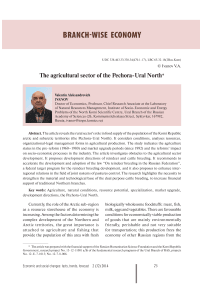The agricultural sector of the Pechora-Ural North
Автор: Ivanov Valentin Aleksandrovich
Журнал: Economic and Social Changes: Facts, Trends, Forecast @volnc-esc-en
Рубрика: Branch-wise economy
Статья в выпуске: 2 (32) т.7, 2014 года.
Бесплатный доступ
The article reveals the rural sector’s role in food supply of the population of the Komi Republic arctic and subarctic territories (the Pechora-Ural North). It considers conditions, analyses resources, organizational-legal management forms in agricultural production. The study indicates the agriculture status in the pre-reform (1960-1980) and market upgrade periods (since 1992) and the reforms’ impact on socio-economic processes in the industry. The article investigates obstacles to the agricultural sector development. It proposes development directions of reindeer and cattle breeding. It recommends to accelerate the development and adoption of the law “On reindeer breeding in the Russian Federation”, a federal target program for the reindeer breeding development, and it also proposes to enhance inter-regional relations in the field of joint systems of pastures control. The research highlights the necessity to strengthen the material and technological base of the dual purpose cattle breeding, to increase financial support of traditional Northern branches.
Agriculture, natural conditions, resource potential, specialization, market upgrade, development directions, the pechora-ural north
Короткий адрес: https://sciup.org/147223586
IDR: 147223586 | УДК: 338.463.33:330.34(470.1-17) | DOI: 10.15838/esc/2014.2.32.8
Текст научной статьи The agricultural sector of the Pechora-Ural North
Currently, the role of the Arctic sub-region as a resource storehouse of the economy is increasing. Among the factors determining the complex development of the Northern and Arctic territories, the great importance is attached to agriculture and fishing that provide the population of this area with fresh biologically wholesome foodstuffs: meat, fish, milk, eggs and vegetables. There are favourable conditions for economically viable production of goods that are mainly environmentally friendly, perishable and not very suitable for transportation; this production frees the economy of other Russian regions from the need to harvest, process and transport the equivalent amount of such products. At that, investments in transport are saved, product losses reduced, its quality improves.
Traditional forms of economy are mostly used by indigenous peoples of the North. In pre-reformed period more than 62% of representatives of small peoples were employed in the agriculture and fisheries sector. The data of the 2006 All-Russian Agricultural Census showed that in large and medium agricultural enterprises 15% of representatives of numerically small peoples were engaged in northern reindeer breeding, horse-breeding and fishing; 10% were engaged in hunting, 15% – in the processing of products of traditional and other industries. These figures were, respectively, 16, 35 and 20% in small agricultural enterprises [5].
The object of the study is the economic entities of the agrarian sector of the Arctic and subarctic areas of the Komi Republic (Pechora-Ural North) that are included in such city districts as Vorkuta, Inta, Usinsk, and municipal districts – Pechorsky, Ust-Tsilemsky and Izhemsky districts. The sub-region under consideration is characterized by abundance of mineral and fuel-energy resources. It has significant reserves of coal, oil, gas, chromium, manganese, diamonds, vermiculite, nickel, copper and other rare metals. Industrial character of functioning of the Arctic subregion makes it possible to allocate a significant share of financial resources for the development of the agricultural and food sector and rural areas.
In the early 20th century A.V. Zhuravsky, the founder of agricultural science in the European North of Russia, proved that farming was possible in northern territories. The Pechora Agricultural Experimental Station was opened in Ust-Tsilma in 1911 by the Order of Russia’s Department of Agriculture . Zhuravskiy was the founder and first Director of the Station. He proved that “it is not the climate that impedes
Pechora’s agricultural development, but the conditions that have nothing to do with the climate. And we hope that a time is coming when the abundance of light near the Pole will be used for the welfare of Russia...” [3, p. 64]. N.I. Vavilov, D.N. Pryanishnikov and other scientists substantiated the expediency of the “northering” of agriculture.
The works [1; 4; 6; 7] contain practical recommendations on food security of the population in the Arctic areas of the EuroNorth-East, on the development of reindeer breeding, fodder production through the grassing of the tundra.
Specifics of functioning of the agrarian sector
Agroclimatic conditions in the sub-region impede the effective development of agricultural production. Conditions for agriculture are especially unfavorable in the urban districts of Vorkuta and Inta, where tundra soils prevali and thermal resources are very limited. Most of the territory is permafrost. Fodder production development in the Arctic zone is possible by the grassing of the tundra [6]. However, it should be noted that, there are favorable conditions for the development of agriculture in the basin of the Pechora river (sufficient rainfall, which provides a relatively high efficiency of fertilizers; long light day, which makes the growth of plants more rapids; vast floodplain meadows). Due to the long light day, the grass in the Arctic zone is growing with high intensity; as a result, the amount of green mass that is formed within 180 vegetation days in southern regions, here is formed within 70–80 vegetation days. Average daily growth of grasses in the beginning of spring in the auspicious days is 3–9 cm [2]. The potential for collection of forage from the flooded meadows in the subregion exceeds 17 thousand tons of forage units.
Labor resources . At present only 1.8 thousand people are employed in the agricultural sector in the Pechora-Ural North, whereas in 1989 this figure was over 8 thousand people.
Municipal unitary enterprises that produce agricultural goods have 12.4% of the total number of agricultural workers, limited liability companies – 46.9%, cooperatives – 19.1%, peasant (farm) enterprises – 10.2%, joint-stock companies – 11.3%.
The sector experiences a shortage of specialists, middle managers, farm machinery operators, milking machine operators and reindeer herders. There is a high turnover of personnel, low level of education of managers and specialists.
Land resources. The total land area is 15.7 million hectares, including 9.5 million hectares of reindeer pastures, 44% of which are located in the Nenets Autonomous Okrug. Only a small part of the land is used for agricultural purposes – 0.8%, and the share of arable land is only 0.08% of the land area. A higher level of land development for growing crops is typical of Izhemsky district (0.2%). There are 0.5 hectares of farmland and 0.05 hectares of arable land per one citizen of this territory.
The farmland structure is dominated by forage grassland – hayfields and pastures. For instance, there are 7.8 hectares of meadows per hectare of arable land.
The analysis of agricultural resources has shown that the considered Arctic territories have less biological resources per capita (except for the natural pastures and deer population) in comparison with other municipalities and the Republic in general (tab. 1) . Moreover, with the twofold population decline in 1990–2012, the availability of sowing land per capita decreased in 3.2 times, the availability of cattle – in 6.1 times, poultry – in 5.6 times; the number of reindeer increased in 1.9 times (fig. 1) .
Low availability of resources hinders the self-sufficiency of the population of the Arctic sub-region in terms of local foodstuffs. Given the specifics of agricultural production in the Arctic zone, in the future it is necessary to focus on the municipalities of the southern and central regions where conditions for farming are more favorable.
Table 1. Agricultural resources (per 100 people) in 2012
|
Municipal entity, region |
< |
та |
1 |
S |
со |
со |
та |
|
|
Vorkuta |
10.9 |
6.1 |
0.01 |
0.005 |
23.6 |
0.8 |
0.2 |
- |
|
Inta |
33.3 |
3.3 |
2.3 |
1.0 |
103.8 |
0.08 |
0.6 |
488 |
|
Usinsk |
27.3 |
2.9 |
3.7 |
1.5 |
57.0 |
0.4 |
0.7 |
- |
|
Pechorsky District |
34.5 |
2.9 |
1.8 |
0.7 |
- |
0.3 |
0.4 |
- |
|
Ust-Tsilemsky District |
355.6 |
11.2 |
25.6 |
11.1 |
6.6 |
0.03 |
11.1 |
- |
|
Izhemsky District |
144.7 |
16.3 |
16.9 |
9.9 |
46.0 |
0.03 |
4.1 |
- |
|
Pechra-Urals North |
48.4 |
5.4 |
3.8 |
1.8 |
35.6 |
0.4 |
1.1 |
67.6 |
|
The rest of the territories of the Komi Republic |
47.1 |
13.8 |
4.5 |
2.0 |
- |
3.4 |
2.1 |
242 |
|
Komi Republic |
47.5 |
11.6 |
4.3 |
1.9 |
10.2 |
2.5 |
1.9 |
192 |
|
* Data on agricultural organizations. Calculated according to: 1. Sel’skoe khozyaistvo v Respublike Komi. 2013: stat. sb. [Agriculture in the Komi Republic. 2013: Statistical Digest]. Komistat. [Territorial Body of the Federal State Statistics Service in the Komi Republic]. Syktyvkar, 2013. 2. Goroda i raiony Respubliki Komi. 2013: stat. sb. [Towns and Districts of the Komi Republic. 2013. Statistical Digest]. Komistat. [Territorial Body of the Federal State Statistics Service in the Komi Republic]. Syktyvkar, 2013. |
||||||||
Figure 1. Dynamics of biological resources (per 100 people) in the Pechora-Ural North for 1990–2012, (1995 = 100%)
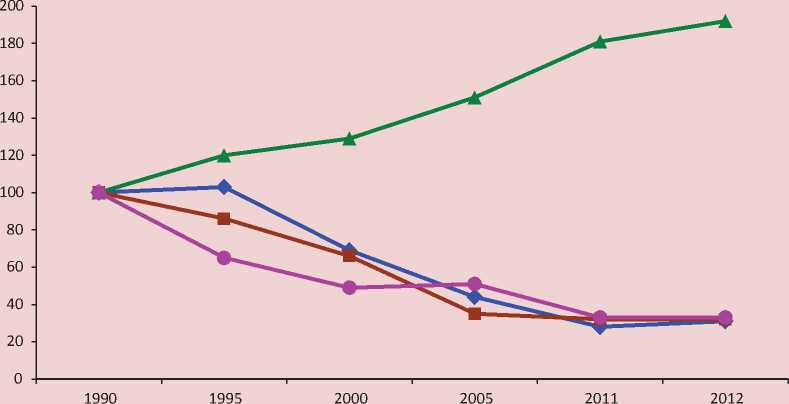
I Land under cultivation — ■ — Cattle — —Reindeer ^c=> Poultry
Specialization and organizational-legal structure of agriculture
Agriculture in the areas under consideration is specialized in the production of the products of reindeer breeding, poultry farming and cattle breeding. This specialization was formed under the influence of natural conditions, geographical location, natural-historical and socio-economic factors and the needs of the society. The share of animal husbandry in the Arctic and subarctic zone of the Komi Republic in 2012 accounts for 71% of the gross output of agriculture, the share of plant cultivation is 29%.
Agricultural goods are produced in 28 collective organizations, 23.4 thousand households and 119 peasant (farm) enterprises. In its total volume, the share of agricultural production cooperatives is 28.6%, limited liability companies – 60.7%, jointstock companies – 7.1% and state unitary enterprises – 3.6%.
Agricultural companies are engaged mainly in the production of eggs (Inta Poultry Plant – 99%), reindeer meat and beef (56%); households are engaged mostly in the production of potato (96%) and vegetables (99%). The share of agricultural enterprises in the total volume of milk production is 40%, population households – 48%; peasant (farm) enterprises do not play a significant role in the production of agricultural products. They account for 12% of milk; 4% of meat; 2.9% of potato and 0.2% of vegetables (fig. 2) .
When dealing with the issue of promising types of farming in the Northern and Arctic territories, it is important to consider a more pronounced tendency of rural workers towards collective work. Here they count on the support of the team in the time of need, on its help in working on subsidiary household plots; they see a secure job.
Besides, the Soviet period contributed to the formation of a rural way of life, based on
Figure 2. Share of different types of farms in the Arctic and subarctic zone of the Komi Republic in production in 2012, %
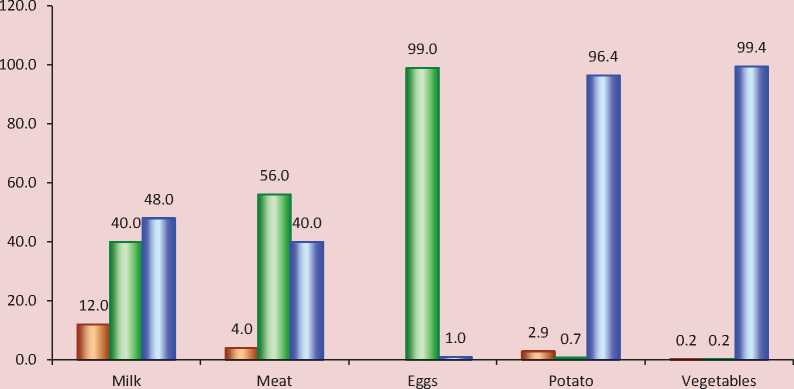
□ Farming enterprises □Agricultural organizations □Subsidiary household plots
the work of peasant farmers in collective farms. Therefore, it is necessary to restore medium and large agricultural production, which is integrated with processing industry and which should form the basis for the agricultural economy.
Due to the reduction of rural households, deterioration of demographic situation in rural areas, ageing of rural population, decrease in the share of capable persons, low production efficiency based on manual, low-skilled labor, it would be wrong to focus on private farms of citizens as the basis for creating the food fund. Currently, their vast majority relates to a consumer type. Besides, since 1995, crop areas, livestock and production are reduced in the population’s households.
The farmer setup in the medium term will not get significant development. The formation of peasant farming requires large investments for the creation of material base and infrastructure, a lot of time, competent workers, adapted to market conditions.
Agriculture in the pre-reform period
In the pre-reformed period the agriculture in the Pechora-Ural North experienced progressive changes of technological, economic, social and organizational nature. The strategy for the development of agriculture in these years was determined by intensification of production by strengthening the material and technological base. For 1985–1990 the investment in industry increased by 3.3 times, provision with fixed assets (basic production assets per 100 hectares of farmland) of agricultural enterprises increased in 1.4 times.
All this contributed to the improvement of major production indicators of agriculture and, first of all, its leading sector – livestock breeding. Meat production in all categories of farms of the Arctic sub-region in 1990, compared to 1965, increased by 4.3 times, milk production – by 1.7 times (fig. 3) .
In the total meat production in the Komi Republic the share of the considered sub-region has increased from 14% in 1965 to 26% in 1990,
Figure 3. Meat and milk production in all types of farms in the Arctic and subarctic territories of the Komi Republic, thousand tons
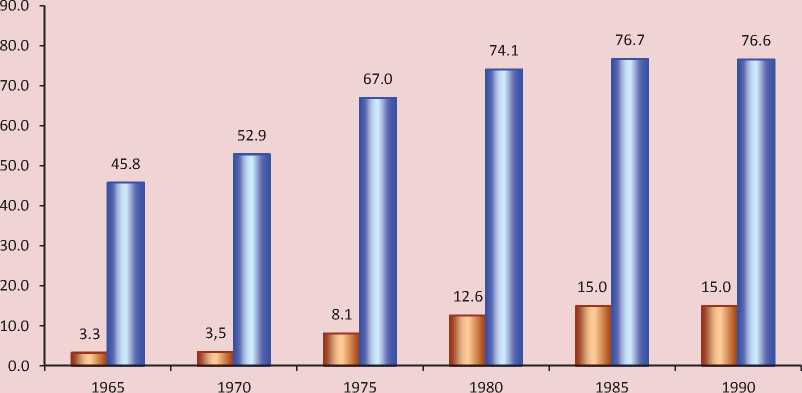
□ Meat □ Milk
milk – from 28 to 37%, eggs – from 5 to 36%. In the early 1970s, egg factories were built in the towns of Vorkuta and Inta; as a result, it satisfied the demand of the population for fresh egg. In order to create a food base, subsidiary plots were developed, they were represented by large farms, functioning at the expense of financial, material and labor resources of mining companies. In 1988 the share of subsidiary farms in Vorkuta and Inta accounted for 100% of vegetables production, and for 76 and 70% of milk and meat production, respectively. The share of rural subsistence farming in the Republic on the whole amounted to 23% of meat production, 27% of milk production, 10% of potato production and 15% of vegetables production.
In the pre-reformed period, all agricultural enterprises and all types of production were profitable. The level of profitability varied from 35% in agricultural enterprises of Vorkuta up to 51% in Ust-Tsilemsky District (tab. 2) .
Livestock production (especially deer meat), was characterized by high profitability, as well as milk and dairy products. In 1990, the level of profitability of reindeer meat was 324%.
Thus, the development of agriculture in the pre-reform period was characterized by good production dynamics. All agricultural enterprises were profitable. The level of profitability has made it possible to implement extended reproduction. Positive changes occurred in the harmonization of conditions and living standards of rural and urban population.
Market reforms in the agrarian sphere
Reforms in agricultural sector were accompanied by a sharp reduction of government funding, decline in investments, accelerated liberalization of prices for material and technological resources, which led to the price disparity. This impeded the machinery and technological re-equipment of agricultural production, and social transformations in rural
Table 2. Profit and profitability of production in agricultural organizations of the Arctic and subarctic regions of the Komi Republic for 1989
|
Indicator |
Town |
District |
||||
|
Vorkuta |
Inta |
Usinsky |
Pechorsky |
Ust-Tsilemsky |
Izhemsky |
|
|
Profit, thousand rubles |
464 |
1601 |
3213 |
3556 |
6145 |
6109 |
|
Profitability of the whole activity, % |
34.8 |
40.1 |
54.4 |
50.5 |
51.1 |
46.0 |
|
Plant cultivation |
- |
- |
56.1 |
12.7 |
29.8 |
|
|
Animal husbandry |
34.8 |
40.1 |
54.4 |
60.2 |
51.4 |
46.3 |
|
Milk and milk products |
... |
77.2 |
70.7 |
66.0 |
64.3 |
|
|
Meat of all types |
38.4 |
21.1 |
33.5 |
30.2 |
||
|
Beef |
10.1 |
22.1 |
34.3 |
29.4 |
||
Source: Osnovnye pokazateli khozyaistvennoi deyatel’nosti sovkhozov za 1989 g. [Main Indicators of Economic Activity of State Farms for 1989]. Komi respublikanskoe upravlenie statistiki [Komi Republic Department of Statistics]. Syktyvkar, 1990.
Table 3. Availability of main types of machinery and power capacities in the agricultural enterprises of the Pechora-Ural North to the end of the year, units
The application of organic and mineral fertilizers decreased dozens of times: 198.3 thousand tons of organic fertilizers were applied in 1990, in 2012 – only 6.6 thousand tons, mineral fertilizers – 23 272 and 538 centners, accordingly. This leads to the removal of nutrients from the soil exceeding their inflow with fertilizers.
Market transformation was accompanied by agricultural production decline. For 1990– 2012, the production of meat (mostly beef) in
Figure 4. Dynamics of production of animal husbandry in all categories of farms of the Arctic sub-region in the Komi Republic for 1990–2012, (1990 = 100%)

all categories of farms in the Arctic sub-region decreased in 3.5 times, milk production – in 5.3 times, eggs production – in 4.7 times (fig. 4) . In the rest of municipal entities the reduction in meat production amounted to 1.5 times, milk production – 2.8 times, eggs production – 2.2 times.
At the twofold decline in the number of population in the subarctic region, the production of meat per person decreased in 1.8 times, milk – in 2.7 times, eggs – in 2.4 times. In the other regions and towns when the population decreased by 18%, production per capita declined, respectively, in 1.3; 2.3 and 1.8 times.
The rates of production decline in the Arctic and subarctic areas were significantly higher than in other areas of the Republic. For the analyzed period the share of the sub-region in the production of all kinds of agricultural products decreased, while the share of other areas increased (fig. 5) .
The reduction in the production of agricultural products has led to a constant reduction in the provision of the population with local foodstuffs. The main food resources are formed at the expense of import from other regions of the country and from abroad.
The decline in the production of local products was caused by the reduction of crop areas and the number of livestock. These indicators declined most rapidly in agricultural enterprises. In 1990–2012, their crop areas decreased in 11.2 times, cattle head – in 12.3 times, poultry – in 5.6 times.
In agricultural organizations the principle of self-repayment and self-financing has been violated. The share of unprofitable organizations is 42%. More than half of agricultural enterprises are in a crisis condition.
The main factors hindering the development of the agricultural sector, are as follows: an extremely unsatisfactory condition of material and technological base, low investment
Figure 5. The share of the Pechora-Ural North in the Republic’s animal husbandry production, %
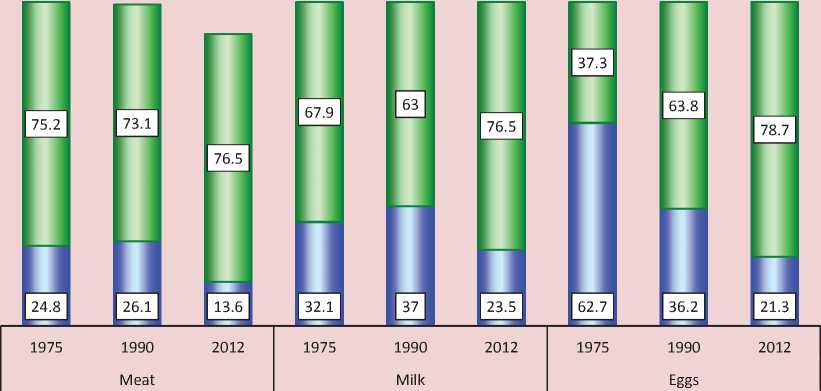
□Arctic sub-region □ The rest of the territory
attractiveness of the industry, limited financial resources of business entities, insufficient and inefficient mechanisms of state support of the agrarian sector, lack of qualified staff, low salaries, poor development of production and market infrastructure, deterioration of the social sphere in rural areas. Constraints on the development of the sector are shown in figure 6 .
The Arctic and subarctic territories that are engaged in agricultural production and fishery in extreme conditions, cannot be considered from the perspective of obtaining the profit sufficient for expanded reproduction. The agricultural industry by virtue of its nature is drawn to the social sphere and can develop only with state support. Subsidies to agricultural producers make it possible to get profit in addition to the proceeds from the sale of products without affecting the growth of food prices. Revenue growth increases investment opportunities for modernization and innovation development of agricultural production.
Main directions of development of the agrarian sector
The situation in reindeer herding is relatively stable among the agricultural branches in the region. In recent years, with the adoption of the law “On reindeer breeding in the Komi Republic” and the target program “Development of reindeer breeding in the Komi Republic (2011–2015)”, the sector is experiencing positive changes. In 2012, compared with 2010, reindeer population in all categories of farms increased by 9.3%. Agricultural organizations are increasing their production and sales of meat, improving livability and actual accretion of calves.
80.8 million rubles from the budget of the Komi Republic and 37.6 million rubles from the federal budget were allocated for financial support of the program. This allowed reindeer farms to build three new corrals (Agricultural Production Cooperative “Olenevod”, LLC “Severny” and LLC “Agrocomplex “Inta
Unstable sales of products
Unfavorable conditions and low standard of living
Figure 6. Constraints on the development of the agrarian sector
Monopolism of I and III spheres of agro-industrial complex
Shortage and outflow of qualified personnel
Disparity of prices for agricultural products and industrial means of production that are provided to the village

Pripolyarnaya”), to complete the construction of the third modern slaughter unit in Inta, to purchase snowmobiles, boats, boat engines, diesel power blocks, satellite phones. Geobo-tanical exploration of reindeer pastures was conducted by APC “Olenevod” in 2011 and by LLC “Agrocomplex “Inta Pripolyarnaya” in 2012. 12.2 million rubles was allocated to these purposes from the Republic’s budget. To date, geobotanical surveys of reindeer pastures have been carried out in all the five reindeer herding enterprises in the Republic. The availability of modern slaughter units in APC “Olenevod”, LLC “Severny” and LLC “Agrocomplex “Inta Pripolyarnaya” makes it possible to establish a facility for storage and processing of endocrine glands (endocrine-enzyme raw materials), as well as blood and its components.
The implementation of the target program improved social services and material welfare of reindeer herders and their families. In the framework of the measures on the organization of transportation of reindeer herders’ children from camping grounds to the place of study and back during the summer holidays in 2012 127 children were transported from the tundra and 77 children – to the tundra. Average monthly wage of people employed in reindeer herding has increased by 69% (from 10.5 thousand rubles in 2010 up to 17.7 thousand rubles in 2012).
Although the situation in reindeer breeding in the Komi Republic in comparison with other subjects of the North looks relatively stable, the sector has accumulated a lot of problems. Their origins can be seen both at the federal and regional (inter-regional) level. The absence of a special law of the Russian Federation “On reindeer breeding” creates uncertainty of the position of reindeer breeding in the system of state control and subordination. Strict monetary policy makes it impossible to obtain long-term loans for modernization of production and establishes exorbitantly high interest rates on short-term loans.
The regional and inter-regional levels do not have well-established inter-regional relations in the sphere of joint systems of control over the condition of pastures.
The main problems of reindeer herding development are severe conditions for life and labor, and low wages of herders. For this reason, young people do not want to work as reindeer herders after finishing their compulsory military service. Farms experience a constant shortage of zootechnicians and vets. The lack of veterinary care entails a significant increase in reindeer mortality from diseases and injuries. On average, reindeer farms obtain 8 kg less body weight per adult reindeer.
In accordance with the current forest legislation, reindeer farms, as tenants of forest areas are to carry out a complex of measures for the provision of fire safety during the entire year. Forest pastures are used only during the winter period (5–6 months a year). Reindeer farms bear additional financial costs when extinguishing fires in forests.
In recent years, as a result of industrial development of mineral and forest resources, the reduction of the area and contamination of reindeer pastures continue; the quality of fodders is deteriorating and forage reserves are reducing. Man-made destruction of soil-covering, degradation of grasslands, reduction of fodder stocks and their availability are observed near the sites of exploration, production and transportation of minerals in the tundra and forest tundra, and in the areas of development of forest resources in the taiga. Due to these factors, and also as a result of changes in the organization of grazing (redistribution of pastures between farms of different categories, changes of stock driving roads, delays of herds in areas of corrals, etc.), the reindeer pastures have local areas with unfavorable ecological situation within which reindeer herding is becoming impossible, and on the adjacent areas it is possible only to a limited extent. This led to the increase of the load on the pastures remaining at the disposal of reindeer herders and to the reduction of their reindeer-feeding capacity, disturbance of fodder balance at seasonal pastures in general. It is noteworthy that the landscapes with the most valuable forage resources (tundra and forest tracts) are violated most often.
Geobotanical surveys of the tundra and forest-tundra pastures of reindeer farms in the urban municipalities of Inta and Vorkuta showed a significant decrease in the share of main fodder plants, and absence of lichen forage. There has been an increase in shrubs and uneatable plants.
It is expedient to develop the territories in Northern taiga for the forest reindeer-breeding; it is an alternative solution aimed at the preservation of depleted tundra and foresttundra pastures from irreversible degradation, and the forests of the Far North – from destruction. Northern taiga has the total area of 400 thousand hectares of land.
The Republic has made its first step towards the creation of forest reindeer-breeding. Knyazhpogostsky district is building the fence; and reindeer have been purchased there. This work will help to find out the terms for creating forest herds based on the adaptation of tundra reindeer. There is also a second way. In 2010 design-and-survey and geobotanical works were conducted on the territory of LLC “Agrocomplex “Inta Pripolyarnaya”, and also a plan of land management was drafted for the creation of a pilot forest herd. For this purpose it is planned to purchase reindeer in the Khanty-Mansi Autonomous Okrug that have already been adapted to the year-round maintenance in the forest. This will reduce the cost of building full-scale hedges, and cheapen the actual keeping of animals. This project even has potential investors.
Successful work on the establishment of taiga reindeer husbandry should involve regional researchers and land surveyors. Their participation in the creation of pilot herds of forest reindeer will make it possible to prepare useful recommendations, to find places in the taiga that are suitable for the maintenance of large reindeer herds. Working actively, in 5–7 years the Komi Republic will be able to recreate former forest reindeer herds in Izhemsky, Udorsky and Ust-Kulomsky districts, and, afterwards, to develop taiga reindeer herding in all of the northern and in several central areas of the Republic. This will open up great opportunities for development of tourism connected with reindeer herding. The mapscheme of promising areas for forest reindeer breeding is presented in figure 7.
Further development of reindeer breeding is possible with the active support of the Komi Republic Government in the following areas:
-
• initiating the adoption of the Federal Law “On reindeer husbandry in the Russian Federation”, and also the drafting of the federal target program for the development of reindeer breeding;
-
• expansion of the republic’s target program “Development of reindeer breeding in the Komi Republic” by inclusion of measures to support the establishment of forest reindeer breeding, starting with design and survey works;
-
• consolidation of forest pastures in longterm lease to reindeer breeding farms;
-
• creation of facilities for processing of reindeer herding products together with other reindeer herding regions. Potential investors can be attracted by the projects for processing of reindeer skins in the urban district of Inta, and
Figure 7. Map-scheme of promising areas for forest reindeer breeding in the Komi Republic
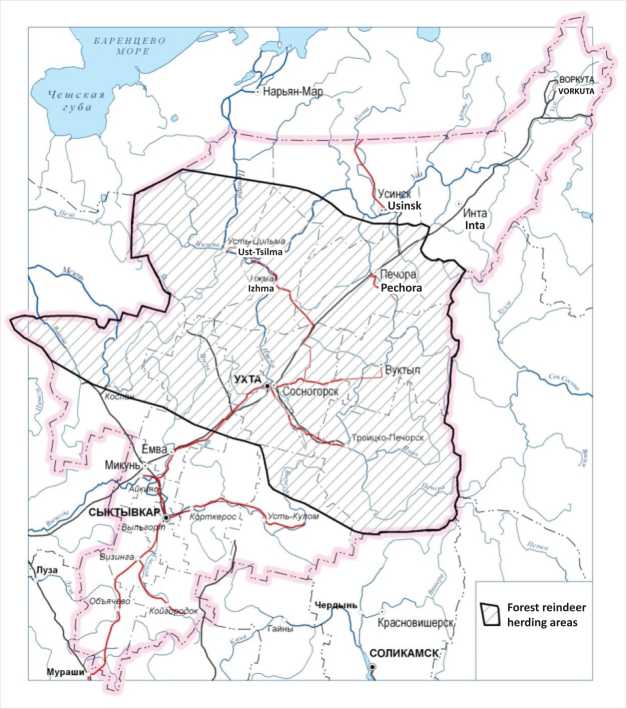
for the production of valuable and profitable endocrine-enzyme raw materials, which is in great demand abroad;
-
• provision of support to organizations that are willing to organize tourism associated with reindeer breeding;
-
• creation of a specialized structural unit for extinguishing fires in the northern woods with the release of deer-breeding farms from these duties;
-
• introduction of a monthly fee to veterinary specialists working directly in reindeer herding.
The municipal district of Pechora requires the construction of a dairy complex for 400 cows to provide the population with whole-milk and dairy products. In small rural settlements it is advisable to build dairy farms that maintain 100–200 cows with high productivity level (5–5.5 thousand kg), consistent with the principles of production of organic products. Modern highly effective means of mechanization and automation for manufacturing processes can be applied in such farms as well. It is also possible to process some of the milk into butter and cheese.
Highly qualified workers, managers and specialists play an important role in the boosting of modernization and innovation development of the agrarian economy in the Arctic and subarctic territories. The staffing of modernization processes requires the implementation of the set of measures proposed by V.V. Terentyev [8].
It will be necessary to enhance state support of traditional industries of indigenous peoples in the Arctic and subarctic regions from the federal budget. It is expedient to carry out such support in the following directions:
-
• funding of the programs for development of reindeer herding, aimed at stabilization and increase of livestock population, complex processing of products and raw materials of reindeer husbandry that are in great demand both in the domestic and international market;
-
• allocation of subsidies for elimination of poverty of the indigenous rural population;
-
• partial compensation of the cost of modern machinery and equipment, mineral fertilizers, fuel, spare parts, combined feeds, purchased by agricultural producers;
-
• compensation of tariffs in the amount of 50% when transporting material and technological resources by railway and water; compensation of part of expenses for power and thermal energy, and natural gas, which are used for technological needs;
-
• subsidizing of interest rates on loans;
-
• assistance to rural cooperatives (in production, marketing, processing, procurement, lending and insurance of agricultural producers);
-
• financing of scientific research in the field of agriculture and fishery.
At the regional level it is proposed to maintain the subsidizing of interest rates on loans for companies of agri-food sector, grant agricultural producers a remission of property and transport taxation.
The accession of the Russian Federation to the world trade organization (WTO) will require certain corrections to be made due to the restrictions envisaged by the WTO in the sphere of state support of agriculture in the Far North and the Arctic. It is necessary to remove restrictions on the “yellow basket” for agriculture functioning in extreme conditions.
In the conditions of WTO membership it is reasonable to exempt the peasants from all taxes for 5 years, like it is done in some regions of China, and increase the role of long-term credit. Concessional loan for the construction and modernization of cattle-breeding facilities in conditions of the North and Arctic should be granted for 20–25 years, and for the acquisition of machinery and equipment – for 6–8 years.
The study of the conditions and problems of development of the agrarian sector in the Arctic and subarctic areas of the Komi Republic leads to the following conclusions.
-
1. The agricultural sector provides the population with fresh, wholesome food, and ensures people’s employment; it also performs the functions of the traditional lifestyle of indigenous peoples.
-
2. The agrarian sector has the following prerequisites for development: availability of labor resources, natural forage base (vast floodplain meadows), production of organic products, demand for local products.
-
3. Evaluation of agricultural development shows that the highest rates in the industry were achieved in the pre-reform period; transformation processes on 1990–2000 led to a decline in production, degradation of resource potential and decrease in the standard of living and quality of life of peasant farmers. If the situation remains as it is today, it will make the trend of destruction of agriculture irreversible.
-
4. There remain certain obstacles to the development of the agricultural sector: extremely unsatisfactory condition of the
-
5. The most important directions of development of local agricultural production are: modernization of production with the use of innovation technologies; improvement of legislation and target-oriented management; creation of conditions for the elimination of the deficit and outflow of skilled workers from the sector; increase of direct state support to the agrarian sector; sustainable sales of agricultural and fishery products; participation of resource enterprises in the financing of food production. In the nearest future it will be necessary to solve modernization and social issues in the agricultural sector.
material and technological base of agricultural enterprises and peasant farms, low investment attractiveness of the industry, limited financial resources of business entities, insufficient state support of the agrarian sector and unavailability of preferential loans, lack of qualified staff, low level of management and unsustainable marketing of agricultural products.
Список литературы The agricultural sector of the Pechora-Ural North
- Gagiev G.I. Nauchnye osnovy molochnogo skotovodstva na Severe . Moscow, 1998. 448 p.
- Gagiev G.I., Chernov B.A. Puti intensifikatsii kormoproizvodstva na severe Komi ASSR . Kormoproizvodstvo na Krainem Severe , 1981, pp. 23-32.
- Zhuravskii A.V. Izbrannye raboty po voprosam sel’skokhozyaistvennogo osvoeniya pechorskogo Severa . Syktyvkar, 2007. 107 p.
- Ivanov V.A., Bezumov L.V. Olenevodstvo Severa . Region , 2013, no.7, pp. 36-39.
- Itogi Vserossiiskoi sel’skokhozyaistvennoi perepisi 2006 goda: v 9 t. -T. 7. Sel’skoe khozyaistvo raionov Krainego Severa i priravnennykh k nim mestnostei . Federal’naya sluzhba gosudarstvennoi statistiki , Moscow: IITs “Statistika Rossii”, 2008. 391 p.
- Kotelina N.S., Archegova I.B., Ivanov V.A. Proizvodstvo kormov v usloviyakh Krainego Severa . Vestnik sel’skokhozyaistvennoi nauki , 1985, no.7, pp. 37-44.
- Rochev P.A., Torlopov F.P., Shekhunov A.F. Opyt sozdaniya sobstvennoi prodovol’stvennoi bazy v raione Pechorskogo ugol’nogo basseina . Sel’skokhozyaistvennoe osvoenie Severa SSSR . Novosibirsk: Zapadno-Sibirskoe kn. izd-vo, 1973. Vol. 1. Pp. 72-86.
- Terent’ev V.V. Kadrovoe obespechenie modernizatsii sel’skogo khozyaistva severnykh i arkticheskikh territorii (na primere Respubliki Komi) . Ekonomicheskie i sotsial’nye peremeny: fakty, tendentsii, prognoz , 2013, no. 4(28), pp. 151-165.
- Osnovnye pokazateli khozyaistvennoi deyatel’nosti sovkhozov za 1989 g. . Komi respublikanskoe upravlenie statistiki . Syktyvkar, 1990
- Sel’skoe khozyaistvo v Respublike Komi. 2013: stat. sb. . Komistat. . Syktyvkar, 2013.
- Goroda i raiony Respubliki Komi. 2013: stat. sb. . Komistat. . Syktyvkar, 2013.

